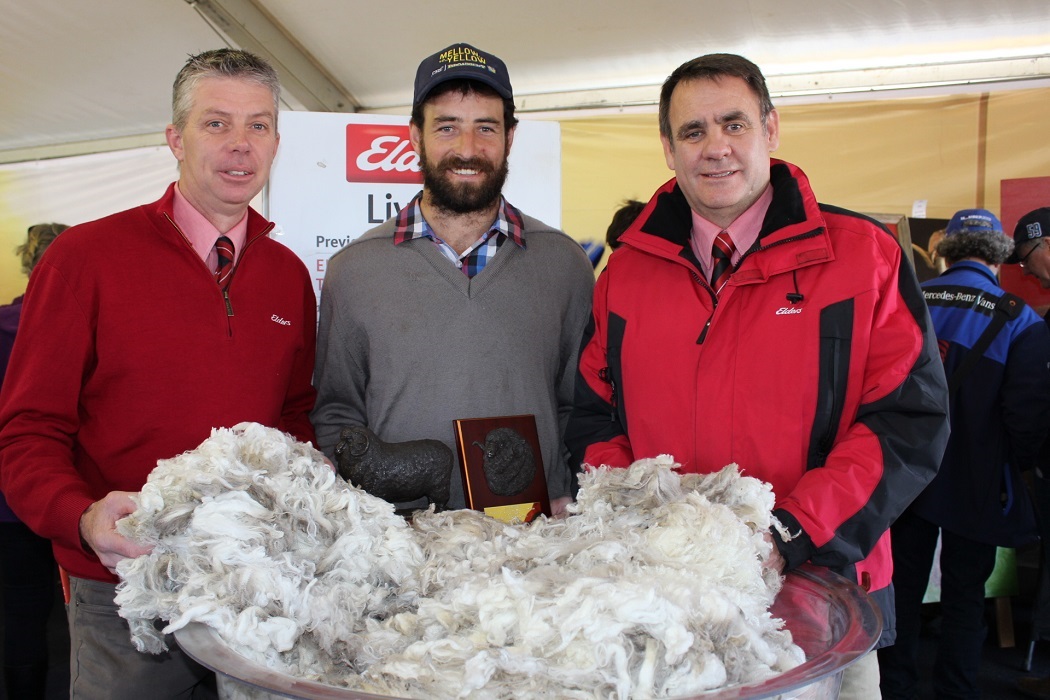
Elders district manager Craig Potter, left, with Southern Clip of the Year winner Sean McDougall and branch network general manager Richard Norton.
A SWITCH to eight-monthly shearing and containment yard use has helped Tatyoon’s sixth generation fine wool operation Roseville Ridge take out the prestigious Elders Southern Clip of the Year award at Hamilton’s Sheepvention rural expo.
Elders wool technical co-ordinator Sam Wan said taking home the most sought after ram at Sheepvention were Bruce and Maryanne McDougall and their son Sean and daughter-in-law Leila Sweeney McDougall.
The 1320 hectare sheep, cattle and grains enterprise runs 3000 Merino breeding ewes. Ms Wan said Rosevale Ridge clip this year displayed excellent style, evenness and had a low mid-point break coupled with high tensile strength. It was well-classed by Sean McDougall and accompanied by a textbook perfect specification, Ms Wan said.
Sean said the clip had been nominated for the award twice before.
“This year everything fell into line basically, we had better test results – higher tensile strength and low mid-break.”
The clip featured young ewe wool tensile strength results of up to 54N/kt for six months’ growth.
“The main line of ewes was 43-45N/kt for eight months shearing.
“They were shorn in June in 2018 and March in 2019.”
The Rosevale flock is in its third year of being shorn at around eight month intervals and Sean said with lambing, this could get longer. This enabled less crutching and chemical use for flystrike prevention.
“We still put Clik on at lamb marking time and at the start of October.
“The containment yards probably helped a lot with the tensile strength and low vegetable matter content.”
The use containment yards for the past five years to improve pasture utilisation and sustainability has enabled better regulation of feed intake and quality to manage wool tensile strength in varying conditions.
The Marcus Oldham and Lifetime Ewe Management Program graduate said a key profit driver is lamb survival. He has been able to lift lamb foetus survival in scanned twinning ewes from 67 percent to 78pc last year. He has been doing work with the Willaura BestWool BestLamb Group to reduce mob sizes to also improve lamb survival. Marking percentages are now around 94-95pc, up from as low as 80pc.
Sean said he had also done trials on tail stripping to reduce mulesing.
“The wethers haven’t been mulesed for two years now.”
The McDougall family first settled in the Maroona-Tatyoon district in 1870 to breed Merinos from Hope Plains, Poplars and Kooringa bloodlines.
Rosevale is based on Sohnic merino bloodlines with Coryule genetics, a Nerstane bloodline. recently a ram was purchased from Stud Park South, Willaura to complement the breeding program. The McDougalls also breed their own rams, which are classed by Elders sheep classer Glendon Hancock and under the guidance of Elders district wool manager Craig Potter.
The Rosevale principals have found that shearing every eight months – generally June, March and December — spreads the wool market risk, maintains heathy sheep and ensure ewes are in a constant condition score for lamb survival.
Ms Wan said the bold crimped, soft-handling and high-yielding Rosevale clip is very sought after by the trade. It measures an average of 19 micron wool of 75-80 mm staple length, with lines of a tensile strength of 45 Newtons/kilotex-plus.
Ms Wan said Leila also has her own fashion label producing woollen scarfs and dresses, and in October each year the family organised ‘Mellow in the Yellow’, a marquee of entertainment located in a flowing canola crop at Tatyoon, as part of the Live Rural event, which focussed on raising funds to support Australian farmers.

An interesting article like others on the same topic, but as usual there are no costings like the extra shearing, freight, commission and how much do they cut each time. Sure the wool looks good at eight months, but does it stack up? And with the containment feeding, again no costs. With the current price of fodder does it pay? Why don’t any of the farmer’s stories have a cost benefit analysis of their “amazing” projects in the press?